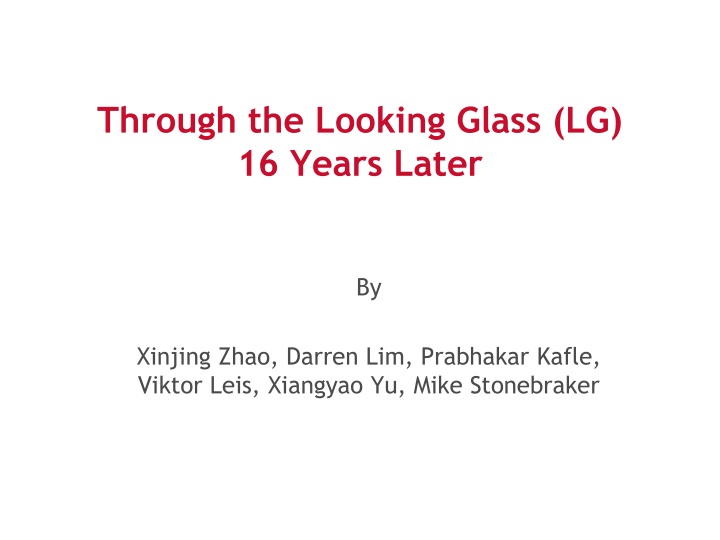
Innovations in Database Management Systems: A Look Beyond LG
Discover the evolution of DBMS technologies post-*Looking Glass* analysis. Explore challenges and advancements in OLTP innovation, addressing critical issues in server-client communication, stored procedures, and benchmarking methodologies. Stay informed about the current landscape and emerging trends in database management systems.
Download Presentation

Please find below an Image/Link to download the presentation.
The content on the website is provided AS IS for your information and personal use only. It may not be sold, licensed, or shared on other websites without obtaining consent from the author. If you encounter any issues during the download, it is possible that the publisher has removed the file from their server.
You are allowed to download the files provided on this website for personal or commercial use, subject to the condition that they are used lawfully. All files are the property of their respective owners.
The content on the website is provided AS IS for your information and personal use only. It may not be sold, licensed, or shared on other websites without obtaining consent from the author.
E N D
Presentation Transcript
Through the Looking Glass (LG) 16 Years Later By Xinjing Zhao, Darren Lim, Prabhakar Kafle, Viktor Leis, Xiangyao Yu, Mike Stonebraker
Looking Glass Paper (2008) Analyzed the Shore DBMS (Dewitt) a SQL, 2PL, WAL traditional architecture system Warmed so all data in the buffer pool Looked at where the CPU cycles go Benchmark was CPU bound
Looking Glass Paper (2008) From 100K feet 1/3 went to the buffer pool 1/6 to concurrency control 1/6 to crash recovery 1/6 to multi-threading 10% to useful work
To Go a Lot Faster Have to significantly deal with all four sources of overhead!!! !
Lots of OLTP Innovation Since Then Hana H-Store (VoltDB) Hyper LeanStore MemSQL Silo
So What Should We Worry About Now? With these innovations, what is important now?
Two Big Issues with LG and Subsequent Innovation (1) LG only counted server DBMS cycles, NOT the server cycles required to communicate with the (remote) client LG did not measure the complete picture!! It is costly to receive messages from remote clients and send back the answer
Innovations Often Assumed Stored Procedures (SP) All current SP models we are aware of run user code in the same address space as the DBMS i.e. NO ISOLATION In financial services, this is often not acceptable
To Study These Issues We benchmarked VoltDB on YCSB (single record xacts) Voter (5 single record SQL commands) TPC-C Main memory data Partitioned across multiple nodes Such that all xacts are single partitioned
Comments This environment was chosen to go as fast as possible And we fudged TPC-C to be single partition Other benchmarks are already single partition.
Results for the Traditional Client-server Model (Including Required Server-side Networking) Server side TCP-IP CPU cycles are the high pole in the tent 68% of YCSB 63% of Voter 47% of TPC-C Put differently, it costs more to get xacts to and from the server than to execute them
Results for Stored Procedure Execution Server side TCP-IP CPU cycles are still usually the high pole in the tent 68% of YCSB 51% of Voter 23% of TPC-C Knocks down the comm overhead, but unless xacts are very heavy it still is dominant
Dealing with Isolation in a Stored Procedure Model Run stored procedures in a separate address space Gives you client-server performance Separate address space and communicate through shared memory with polling or interrupts Gets you fairly close to non-isolated stored procedures Polling is faster than interrupts
Alternatives to TCP-IP Kernal bypass Using DPDK and F-stack ~2X faster than TCP-IP Yellowbrick showed a similar result in a different context Tried OS-V but that did not help
We are Doing It Wrong Studies that ignore networking are worthless Studies that ignore isolation are flawed
Things to Try Leverage hardware memory isolation? E.g. Multics-style rings Smart NICs? E.g. AWS Nitro RDMA?
Conclusions TCP-IP is a pig Should be sent to the home for tired software Need something lighter weight Better (easier to use) kernal bypass would be nice
Time for New Ideas DBOS using specialized networking No need for all the bells and whistles in TCP-IP E.g. simple byte mover inside DBOS And an external gateway to connect to the internet Linux embedding of DBMS functionality Two talks this afternoon But make sure you handle the high pole






















